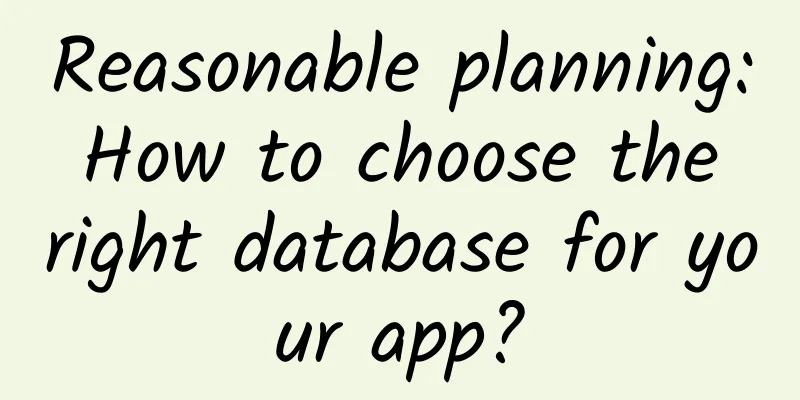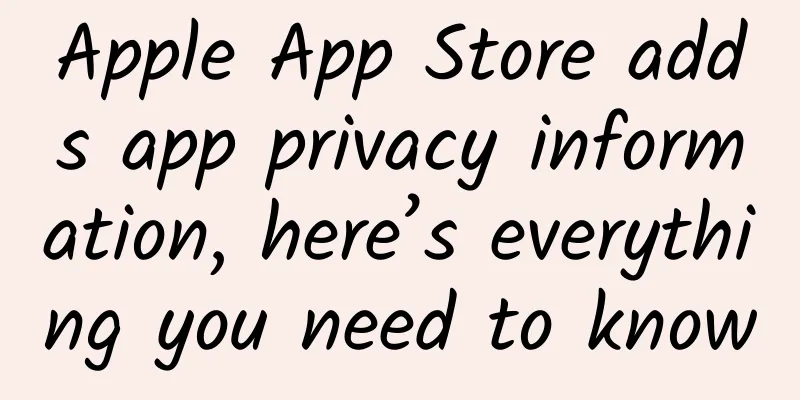Reasonable planning: How to choose the right database for your app?

|
This article is reproduced from the public account "Reading Core Technique" (ID: AI_Discovery) It’s always exciting to start a new project—you have the freedom to design and build it the way you want. But if you don’t plan it well, it will cause trouble in the future. One of the most critical decisions you need to make is choosing an app database, and the purpose of this article is to introduce the database options—listing their advantages and disadvantages to help you choose a database wisely.
Key-valueThe database is structured like a JSON object, each key is unique and each key points to a certain value. It keeps data in memory and runs fast, but has limited capacity, so it is difficult to store large amounts of data. Since there is no hard disk used, it runs very fast. Since there are no queries or joins involved, there is no need to worry about data modeling. Since there is no schema, developers always have the flexibility to change the data to their liking. Conditions of use:
Wide columnWide columns are like key-values on steroids. The value is modified to store a set of columns instead of just plain data. With the introduction of a set of columns, it is now possible to group related data, but there is still no standard schema. Therefore, each key can point to a different group of data. Since it has no schema, it can handle unstructured data and comes with a query language called CQL, which is similar to SQL but much less powerful.Data comes in continuous streams, such as from IoT devices, stock markets, financial transactions, or Netflix viewing history. Conditions of use:
It is still not universal. Therefore, it can be used to store historical data from all different applications. Document databaseIt is one of the most popular database technologies we use. Obviously, it consists of documents, and each document is a set of key-value pairs. They are unstructured and do not require a schema. Documents are grouped into collections, which can be structured into logical hierarchies. Logical data collections group related data in a more logical way, which seems similar to relational databases. The database cannot run join queries, how to get all related data at once? Store them all. Encourage denormalized databases, be prepared for data duplication/inconsistency. Reading data is very fast, but writing and updating data while maintaining consistency is a challenge. Document databases are great for general-purpose applications and probably a good fit for most apps, games, and IoT. If you don't know much about the database schema, logging the database is the best way to start. Popular document databasesWhen the amount of data is large and there are direct or indirect relationships between the data, document-based databases cannot accommodate it. In this case, you must run multiple complex queries and then merge all the received data in the front-end application, or you can use a relational database where these complex queries are managed by the database. Relational DatabaseSome of the most popular databases in this category include MySQL, Postgres, and SQL Server. They have been around for a long time and are good choices for many applications. Imagine a car factory that has different hubs to produce car parts. Suppose the doors are made in one place, while the wheels, body, and interior parts are all made in their own separate places. Hypothetical car factory blueprint Each manufactured part has a unique ID. So once the car is assembled, all the parts can be taken from different places and the car can be assembled. Building such a factory requires a blueprint to be drawn up to ensure that the entire production process is very efficient and optimized. This blueprint, when used in a database, is called a schema. Therefore, a schema needs to be planned for the database to ensure that the database is also efficient and can meet the data needs of the application. shortcoming:
advantage:
Which is best for you?
If there is no need to create a schema and the relationship is stored directly as data, which one should I use? Graph DatabaseData is stored in nodes and relationships are defined as edges. Let's see how to do it. To find all students studying computer science in a SQL database, you need a lookup/intermediary table that stores a separate record of all students studying computer science. Graphs are simpler and clearer because the relational parts of the data do not have to be stored separately, but are automatically included with the new data. Relationships are easier to record and maintain in diagrams With this new way of directly displaying the relationship between two nodes, complex join queries become simpler, greatly improving the performance of the database compared to SQL. Therefore, this database can be used when the performance of the database is reduced by relying on a large number of join operations. Searchable databaseIf you are building an application like Google where you have to quickly return all matching records for small string query searches, then this is a full text search engine. These databases are based on the Apache Lucene project which started in 1999. Algolia and MeiliSearch are full-text search engines. They look similar to document-type databases. There is an index, and data objects are added to it. The search database engine will analyze all the text in the document and create something called an inverted index. When you query for something, the database only checks the inverted index, which makes the whole process seem incredibly fast, even for large databases. Multi-model databaseThere are many databases to choose from, but the most popular seems to be Fauna. As application developers, we usually only care about JSON, which we can use in the front end of the application. With Fauna, you don't have to worry about data modeling, schemas, scaling, replication, or normalization processes, just get JSON data. Use GraphQL to define how to access the data. Let's take a scenario of an Instagram-like application. We will use JSON to define rules for users, posts, and queries. We just uploaded the GraphQL schema, which automatically created a collection to store the data and an index to query the data. Behind the scenes, it will consider how to utilize different paradigms such as relations, graphs, and documents based on the GraphQL schema you provided. Simply add data in the same way you would in a document database, without the limitations of data modeling. advantage:
shortcoming:
Here are some of the most important features of Fauna worth noting: That’s not all! There are many different databases to learn about, but I hope this introduction will help you have some clarity and direction when designing your applications. |
<<: Central Bank: Digital RMB will coexist with Alipay and WeChat Pay
>>: You can check WeChat chat records by paying money: Is it true?
Recommend
How do rookies promote and acquire customers?
Acquiring new users is the source of growth for a...
Hunter Camp: Zhihu intercepts traffic and detonates the entire network traffic
This course mainly explains how to attract traffi...
Xiaomi YU7 starts large-scale road testing. Can it successfully compete with Tesla Model X when it is launched next year?
Xiaomi's first SUV, the YU7, is undergoing la...
How did "Nezha" gain 15 billion traffic on Douyin without spending any money?
"Nezha" has grossed over 3.5 billion yu...
Why can’t I check the battery health on my Android phone?
As we all know, the iPhone has added the battery ...
LeEco withdraws funding from Aston Martin to start producing electric cars on its own
According to Reuters, Aston Martin plans to scale...
The latest policy on death allowance for only children in 2022: How much is the one-time subsidy?
In May 2022, the Ministry of Finance issued a noti...
How can you make a product go viral even with minimal advertising?
Why is it that even though some products are rare...
New way to monetize incentive videos: How to conquer tool apps?
Native video is attracting more and more attentio...
How to use content to grow products?
Let me explain it simply and literally. What does...
Use of global variables and local variables in Android
As the name implies, global variables are variabl...
S Business School_14-day WeChat Moments copywriting training camp
S Business School 14-day WeChat Moments Copywriti...
Facebook low-cost traffic generation skills!
Marketers often look for ways to get more Faceboo...
Anyone can build their own AI robot from scratch
From driverless cars to software engineering, fro...
Jules Verne's novel predicted air warfare half a century in advance
Editor's Note Military science fiction has a ...









